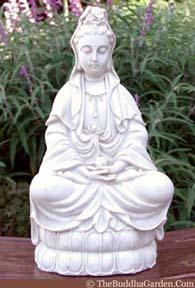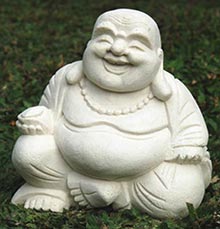(Click To View Larger Image)
Protection Buddha / Overcoming Fear
This depiction of a seated Buddha with the right hand raised and facing outwards has two common meanings. The first is that of the Protection Buddha, as the raised right hand symbolically represents a shield. The second meaning, Overcoming Fear, is closely related to the first (since one who is receiving protection would be less fearful).
The main features of this pose, aside from the raised right hand, is that The Buddha can be depicted either sitting or standing, and the left hand may either be extended outward or palm up in the lap. This statue signifies courage and offers protection from fear, delusion and anger.
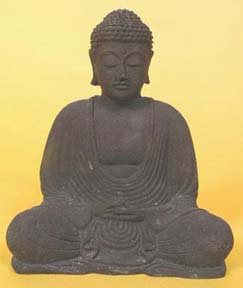 Meditation Buddha
Meditation Buddha
(Click To View Larger Image)
Meditation Buddha / Serenity Buddha / Calming Buddha
Another of the more common rupas is of the Buddha in Meditation. This statue is for people who are either looking for peace and clam in their lives, or for those who wish to improve their own meditation skills. People will often buy a Meditation Buddha if they want to set up a "serenity room" or a corner of their house where they can sit in calm for a little while and unwind.In this pose, the Buddha is depicted with both hands in the lap, face up, and the legs are crossed, either in a Double Lotus pose (with the ankles of each leg tucked behind one another in a locked position), or in a Single Lotus pose (where one leg rests on top of the other leg). Occasionally, an alms bowl is placed in the lap as well.
As this statue generally represents focused concentration, the eyes of the Buddha are either depicted as halfway closed, or closed nearly all the way. The silhouette of the statue is shaped - more or less - like a triangle, which represents stability.
Many of the largest Buddha Statues in Japan, such as the Great Kamakura Buddha Statue at Kotokuin Temple, and large statues in Korea are in the Meditation Pose. This pose is also known as the Amithabha Buddha, which means "Boundless Light."
(Click To View Larger Image)
Calling The Earth To Witness / Earth Touching Buddha
The most common pose you will find in Thai temples is with the legs crossed, the left hand in the lap, and the right hand pointing to the ground with the palm facing inward toward the Buddha. This posture is known as Calling The Earth to Witness, and it is the definition of the moment of enlightenment for the Buddha.It is the story of how the Buddha, after six years, finally was at the verge of enlightenment. Unfortunately Mara, the Demon of Illusion, tried to dissuade The Buddha from the final last steps. The Buddha meditated all night to overcome the fears and temptations sent by Mara, and then called the Earth Goddess to witness that the Buddha achieved enlightenment in order to share with the rest of the world. Witnessing that, the Earth Goddess wrung her hair, releasing flood waters that swept away the Demon Mara and all the temptresses he had released.
(Click To View Larger Image)
The Nirvana Buddha / Reclining Buddha
This statue depicts the Historical Buddha in the last moments of life on earth, prior to the Buddha dying one last time before entering Nirvana (often written in English as ParaNirvana when referring to the life of The Buddha). It is said that an alms giver had accidentally given the Buddha pork that had gone bad, and this eventually led to the death of the Buddha.
Because the Buddha had gained enlightenment in this lifetime, the Buddha was able to escape the endless cycle of birth - death - rebirth (known as samsara) and was able to enter Nirvana. In this pose, the Buddha is always depicted lying on the right hand side on top of a resting table. One of the most well-known examples of this statue is enshrined at Wat Pho in Bangkok, Thailand, although there are numerous other temples throughout Southeast Asia that house statues in the posture.
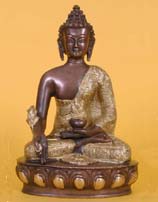 Medicine Buddha
Medicine Buddha
(Click To View Larger Image)
Medicine Buddha
The Medicine Buddha is depicted in paintings having blue skin, but whether shown in statue or painted form, the right hand is held facing downward with fingers extended toward the ground, palm facing outward toward the viewer, a bowl of herbs rests in the left hand upon the lap.It is believed by the Tibetans that the Buddha was responsible for delivering the knowledge of medicine to the people of the world, and in fact the right hand facing outward signifies "granting a boon" (meaning, giving a blessing) to mankind. This is a common hand gesture amongst both Buddhist and Hindu statues.
The Medicine Buddha is venerated by those seeking health, and is more commonly found in the Buddhist temples and communities of Nepal and Tibet.

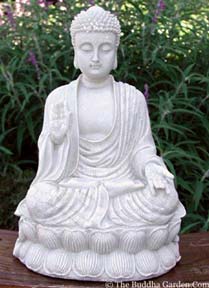
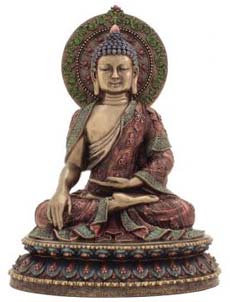
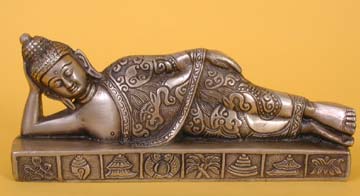


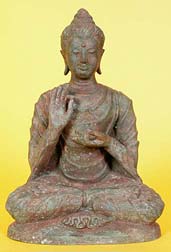
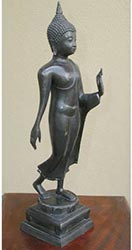
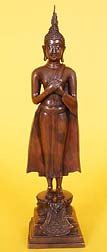
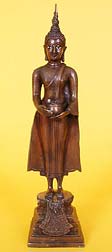
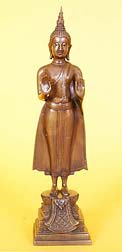
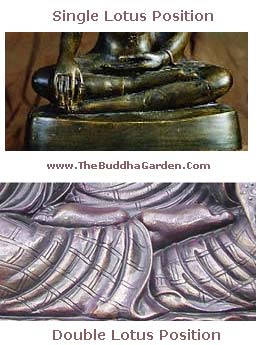 Leg Positions
Leg Positions
